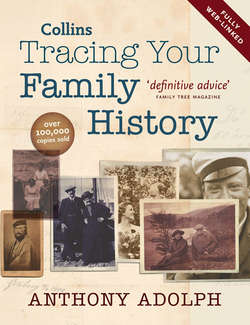Читать книгу Collins Tracing Your Family History - Ryan Tubridy, Anthony Adolph - Страница 7
NEW EDITION
ОглавлениеFAMILY HISTORY is enjoying an extraordinarily dynamic phase and much is changing. In the last few years, internet companies have realised the profits to be made by setting up pay-to-view websites, especially covering the two great building blocks of 19th-century family trees, General Registration and census records. The small amounts paid by users fund further indexing work, thus bringing yet more records within far easier reach of more people than ever before.
These sites have truly revolutionised searching. When I wrote the first edition of this book, I would only have sought people in the 1871 census (for example) if I had a precise address, or had no alternative choice. Now, I can search the entire 1871 census online in seconds. I would make one plea, though: if you are new to this, please don’t take these new developments for granted, or grumble at the relatively very small amounts of money being charged. You are at a vast advantage over genealogists in previous generations. Equally, however, pre-internet genealogists did have to get to grips with and understand how these records worked in far more detail, and this tended to make them very good researchers. So, having saved a lot of time thanks to the internet, why not use some of it to read the relevant chapters of this book, so that you can form a more rounded picture of how the original records were created, and where the originals may be found? This edition is as up-to-date as it can be – yet improvements in accessibility occur almost monthly. These are exciting times indeed.
The first year of this millennium saw two series appearing on national television, BBC 2’s Blood Ties and my own series, Extraordinary Ancestors, on Channel 4. These were followed by further series with which I have been privileged to be involved, particularly Living TV’s Antiques Ghostshow and Radio 4’s Meet the Descendants, which have continued to tell stories of genealogical investigation and discovery.
My mother’s great-grandfather, Rev. Patrick Henry Kilduff – one of a treasure trove of old photographs I was given by a distant cousin whom I had traced in the course of my research.
Millions of people, including you, are now actively investigating their origins, or at least thinking about doing so. This complete guide is intended to cover all the topics you will need to know about how to trace your family tree. You can start at the beginning, letting it guide you through the process of getting started and working back through the different types of records which should, given time and patience, enable you to trace your family tree back for hundreds of years. Or, if you are already a genealogist, you can use it as a reference book to identify and learn more about the vast array of different types of source that may be available for your research.
In some respects, this book follows the standards already set out by its predecessors, and I fully acknowledge my enormous debts to genealogical writers who blazed the trail before me, not least Sir Anthony Wagner, Mark Herber, Terrick FitzHugh, George Pelling, Don Steel, John Titford and Susan Lumas. In other respects, and within the parameters set by what is expected of genealogical reference books, I have tried to add to this my personal perspective, not least by drawing on my experiences in translating genealogy into radio and television.
